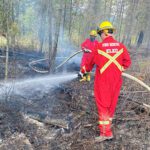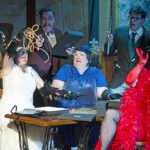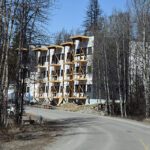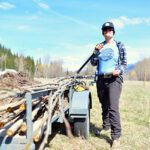Home »

Last chance to register for Stars & Constellations
By Rick Nowell
The deadline for registering for the Stars & Constellations course at College of the Rockies (COTR) is upon us. The Astronomy course begins tonight, Tuesday night, Feb 24; and again Tuesday, March 3 from 7-10 p.m.
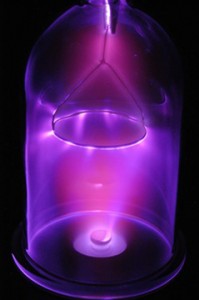 This is not your usual course – we work in the dark!
This is not your usual course – we work in the dark!
We start out in the Physics Lab at COTR and switch off the lights. Then use our glass crystal balls, vacuum pump and 10,000 volts to show the rainbow of colours stars emit in their twinkling brilliance. The pure red and blue emission from nebulae.
We can duplicate the red/green violet flickering glow of the Aurora Borealis in a glass tube (left). (With background astronomy music playing – done by a surprising number of famous rock bands).
 (Right) And if we put a magnet nearby our glass tube (by the white bent section below), we can kink the plasma flow (like the Earth’s magnetic field does to the Aurora).
(Right) And if we put a magnet nearby our glass tube (by the white bent section below), we can kink the plasma flow (like the Earth’s magnetic field does to the Aurora).
 Next we move to a lecture room with a Smartboard and project photos of the most famous constellations – and get you to trace out their outlines by running a finger over the board. We mention the legends given by Greeks and Romans, and the science: why stars are coloured, how they age and nova.
Next we move to a lecture room with a Smartboard and project photos of the most famous constellations – and get you to trace out their outlines by running a finger over the board. We mention the legends given by Greeks and Romans, and the science: why stars are coloured, how they age and nova.
Right is Orion, the hunter. Germanicus Caesar remarked, “No other constellation so accurately represents the figure of a man.” Below his belt (the three close stars) in his scabbard is the brightest nebula, the Great Orion nebula. Notice most of these stars are hot blue-white stars, very short-lived. Which of these stars has turned red and is suffering titanic convulsions–ready to nova soon?
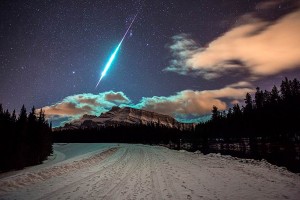 Last we go up on the college roof and Ron Evans gets out his intense green laser and points out each star group; along with a projector screen showing star maps to help. The college’s large binoculars and telescopes can zoom in on these fuzzy patches revealed to be galaxies and glowing rings and bands from colossal nuclear explosions.
Last we go up on the college roof and Ron Evans gets out his intense green laser and points out each star group; along with a projector screen showing star maps to help. The college’s large binoculars and telescopes can zoom in on these fuzzy patches revealed to be galaxies and glowing rings and bands from colossal nuclear explosions.
And we don’t leave out meteors. COTR has a meteor camera that has filmed three nearby meteor impacts since 2011: the latest hit last month on the White River east of Canal Flats.
Picture shown above left, with permission by Brett Abernet, from Johnson Lake near Banff. Looking due south, about 95 km north of Canal Flats. He took the photo on Dec 20, 2014 at 12:20 a.m., while photographing Aurora Borealis. He says it looked just like a welding arc, lit up the entire landscape, and exploded into three pieces.
 The same fireball as seen from Cranbrook (right), about 90 km north through the thin clouds, measuring as bright as the full Moon. With three ground sites having a good fix on it, we have the impact site plotted pretty accurately. We have a couple of meteorites you can pass around, the nickel-iron ones are pretty heavy. But we don’t have the expensive black carbonaceous chondrite type this one likely is.
The same fireball as seen from Cranbrook (right), about 90 km north through the thin clouds, measuring as bright as the full Moon. With three ground sites having a good fix on it, we have the impact site plotted pretty accurately. We have a couple of meteorites you can pass around, the nickel-iron ones are pretty heavy. But we don’t have the expensive black carbonaceous chondrite type this one likely is.
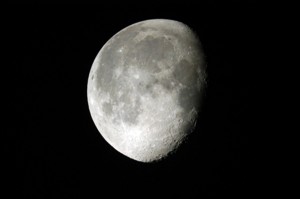 (Left) Here’s the crescent moon as taken through our 10-inch diameter Schmidt-Cassegrain reflector telescope. Can you recognize the ‘Lady in the Moon?’
(Left) Here’s the crescent moon as taken through our 10-inch diameter Schmidt-Cassegrain reflector telescope. Can you recognize the ‘Lady in the Moon?’
Sign up for this interactive Continuing Education course: 6 hours for $79; that’s $13 per hour. Ask for GIRE-400. Not cheap but I think you’ll find it worthwhile.
We also teach Astrophotography!
Lead image: Aurora over Kahn Road.
– All images copyright Rick Nowell, Astronomy Lab Tech at College of the Rockies.

